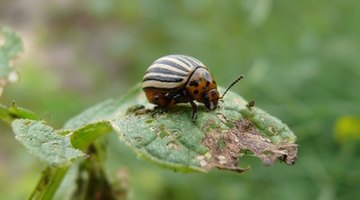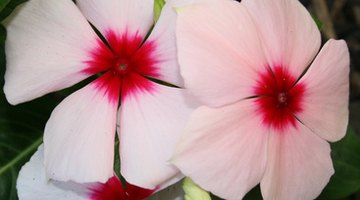Many bugs feed on petunias. These bugs can be very harmful to the host plant, either because of their excessive chewing or due to toxins released during the feeding process which are then absorbed by the plant. Insects that feed on petunias include budworms, potato flea beetles, spotted cucumber beetles, Asiatic garden beetles and ground mealybugs. When feeding in large numbers, all of these insects can be fatal to petunias.
Budworms

The budworm, also known as the petunia or geranium bud worm, is a small worm-like moth larva that feeds on many species of flowering plants, including petunias. Budworms often leave behind distinctive black spots on the leaves and petals of the petunias. This is the worm's faeces, called "frass." Another sign of a budworm infestation is holes in the flower petals and leaves. The budworm pupae burrow in the soil and the budworms emerge in the spring. They are often found within the flower bud of the petunia, which is where they like to feed. This is where they get their name. Budworms are often the same colour as the flower they are feeding on, making them difficult to see.
- The budworm, also known as the petunia or geranium bud worm, is a small worm-like moth larva that feeds on many species of flowering plants, including petunias.
- They are often found within the flower bud of the petunia, which is where they like to feed.
Potato Flea Beetles

The potato flea beetle is a small, round, black insect that feeds on many types of flowering plants, including petunias. The holes that potato flea beetles create by feeding are called "shotholes." Potato flea beetles often eat young plants and seedlings. The plants can die due to the significant damage caused by the beetles' feeding.
- The potato flea beetle is a small, round, black insect that feeds on many types of flowering plants, including petunias.
Spotted Cucumber Beetle

The spotted cucumber beetle commonly feeds on petunias. These beetles lay their eggs near a plant's roots. When the larvae emerge from the eggs, they feed on the root systems of the plant and move upward, feeding on the stem. The plants can die due to the significant damage caused by the beetles or from the bacteria that the beetles carry in their digestive systems which is transmitted to the plant.
- The spotted cucumber beetle commonly feeds on petunias.
- When the larvae emerge from the eggs, they feed on the root systems of the plant and move upward, feeding on the stem.
Asiatic Garden Beetle
The Asiatic garden beetle is a small, light brown beetle approximately half an inch in length. Asiatic garden beetles feed on a variety of flowering plants, including petunias. Asiatic garden beetles usually feed only during the nighttime hours and hide during the day. The beetles chew irregular-shaped holes in the leaves and stems of the plants they feed on.
- The Asiatic garden beetle is a small, light brown beetle approximately half an inch in length.
- Asiatic garden beetles usually feed only during the nighttime hours and hide during the day.
Ground Mealybugs
Ground mealybugs are small, worm-like bugs that have a white-coloured fuzz on the outside of their bodies. They usually measure about 1/8 of an inch in length. Mealybugs are known to feed on flowering plants such as petunias. Mealybugs often feed on the underside of leaves, leaving distinct holes where the stem meets the leaf of the plant. They often release toxins into the plant when they feed and this, in combination with their excessive chewing, can be fatal to the host plant.
- Ground mealybugs are small, worm-like bugs that have a white-coloured fuzz on the outside of their bodies.
- Mealybugs often feed on the underside of leaves, leaving distinct holes where the stem meets the leaf of the plant.
